Contemporary
Artworks Throughout
More Than A
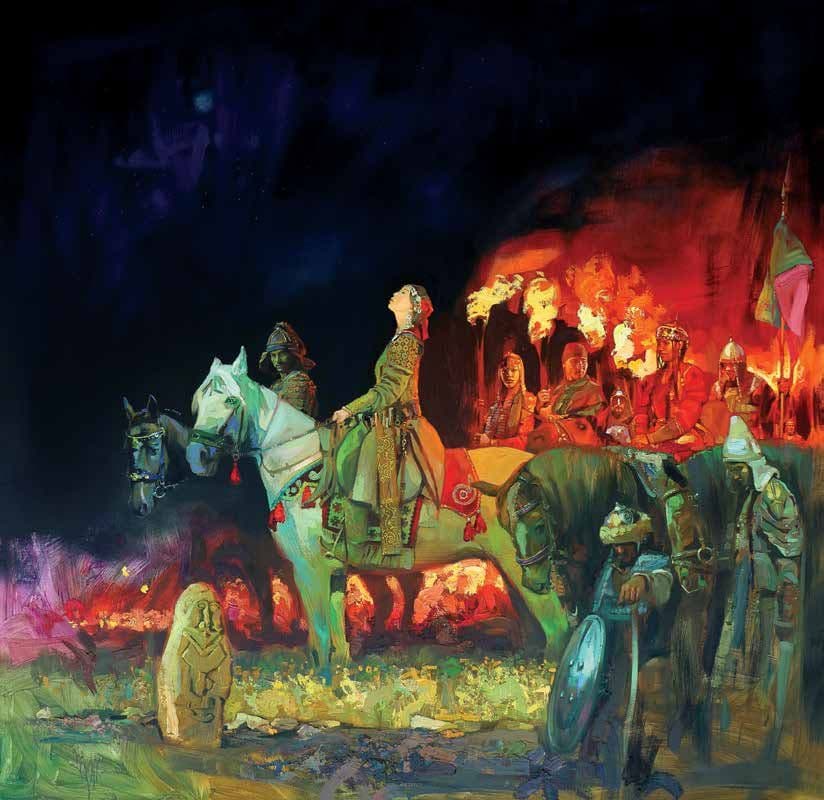 Quarter Century OfIndependence
Quarter Century OfIndependenceThe primary mission of this publication is to fulfill the objectives set forth in the Project “Modern Kazakhstan Culture in the Global World”, which is one of the directions of an extensive state program – «Rukhani Zhangyru», (Spiritual Enlightenment).
The objective of this program is a renaissance of spiritual values of the people of Kazakhstan, taking into account challenges of globalization and risks associated with it. This is feasible on the basis of modernization of public consciousness through competitiveness, pragmatism, preservation of national identity, knowledge cult and evolutionary rather than revolutionary development and candour in the nation’s consciousness. The designated Program is an important strategic priority of the Third Modernization of Kazakhstan, initiated by the President of the Republic of Kazakhstan Nursultan Nazarbayev in 2017.
The publication is addressed to a wide range of audiences.
The primary mission of this publication is to fulfill the objectives set forth in the Project “Modern Kazakhstan Culture in the Global World”, which is one of the directions of an extensive state program – «Rukhani Zhangyru», (Spiritual Enlightenment).
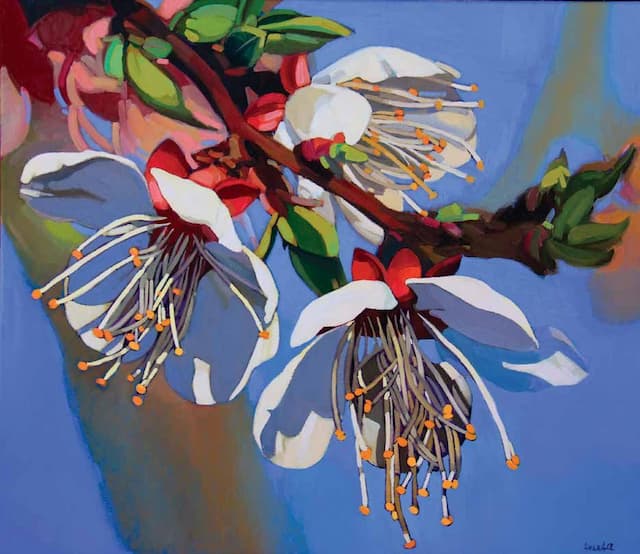

The primary mission of this publication is to fulfill the objectives set forth in the Project “Modern Kazakhstan Culture in the Global World”, which is one of the directions of an extensive state program – «Rukhani Zhangyru», (Spiritual Enlightenment).
The objective of this program is a renaissance of spiritual values of the people of Kazakhstan, taking into account challenges of globalization and risks associated with it. This is feasible on the basis of modernization of public consciousness through competitiveness, pragmatism, preservation of national identity, knowledge cult and evolutionary rather than revolutionary development and candour in the nation’s consciousness. The designated Program is an important strategic priority of the Third Modernization of Kazakhstan, initiated by the President of the Republic of Kazakhstan Nursultan Nazarbayev in 2017.
The publication is addressed to a wide range of audiences.
The primary mission of this publication is to fulfill the objectives set forth in the Project “Modern Kazakhstan Culture in the Global World”, which is one of the directions of an extensive state program – «Rukhani Zhangyru», (Spiritual Enlightenment).

The objective of this program is a renaissance of spiritual values of the people of Kazakhstan, taking into account challenges of globalization and risks associated with it. This is feasible on the basis of modernization of public consciousness through competitiveness, pragmatism, preservation of national identity, knowledge cult and evolutionary rather than revolutionary development and candour in the nation’s consciousness. The designated Program is an important strategic priority of the Third Modernization of Kazakhstan, initiated by the President of the Republic of Kazakhstan Nursultan Nazarbayev in 2017. The publication is addressed to a wide range of audiences.
Cultural Renaissance
of Modern Kazakhstan
Ministerial and Leadership Perspectives

Arystanbek Mukhamediuly
Minister of Culture and Sports of the Republic of Kazakhstan
In more than a quarter of a century since gaining Independence, Kazakhstan has achieved a remarkable success in economics, politics and social development. Our country is recognized and respected in the world community. The state program “Rukhani Zhangyru” (Spiritual Enlightenment), being an important part of the Modernization 3.0 announced by the President of the Republic of Kazakhstan Nursultan Nazarbayev, became a strategic priority for further development and crucial for the future of the nation.
Throughout many centuries a unique culture was formed in Kazakhstan which absorbed all the best, significant and original from each historical era that the Great Steppe experienced. We are proud that Kazakh culture is initially syncretic, carries peace and serenity, promotes mutual enrichment and prosperity. Knowledge and understanding of our own history and national code is the foundation of our spiritual renaissance. Today, the culture of Kazakhstan continues to evolve, based on the same principles of unity and desire for peace as before.
The art of Kazakhstan in the era of Independence is a unique phenomenon with its own recognizable appearance, where all the most significant signs of this time of renewal, awareness and change manifested themselves. The process of bold searches and creative experiments reveals amazing discoveries and masterpieces which the world should learn about.
The “Artists of Modern Kazakhstan” catalog, presented in the framework of “Modern Kazakhstan Culture in the Global World” Project, is an extremely important step in a large and systematic work, the goal of which is successful integration of Kazakhstan’s art into the world cultural space.

Arystanbek Mukhamediuly
Minister of Culture and Sports of the Republic of Kazakhstan

Aida Balayeva
Secretary of the National Commission for the Implementation of the Program of Modernization of Public Consciousness “Rukhani Zhangyru”
Dear friends!
Art has always been and remains an important cultural heritage, reflecting history, traditions and spiritual wealth of any nation.
Over the years of Independence, Kazakhstan raised a whole galaxy of talented and gifted artists, whose works convey cultural image of the country.
The anthology “Artists of Modern Kazakhstan” provides a unique opportunity to get acquainted with profound and original works of the best contemporary Kazakhstani artisans.
Such a large-scale project became possible thanks to the “Rukhani Zhangyru” program initiated by the President of the Republic of Kazakhstan – Nursultan Nazarbayev, which gave new impetus to the spiritual modernization of the Kazakh nation.
Art has always brought together and united nations and also served as a universal tool of dialogue and mutual understanding. I am confident that the works of Kazakhstan artists will contribute to the global cultural heritage and become an asset not only for Kazakhstan, but also for the entire world community.
Acquaintance with the anthology will open up an opportunity for everyone to comprehend the new facets of perception of our country and the diverse world of Kazakhstan painting.
Dialogue of Cultures:
Kazakhstan
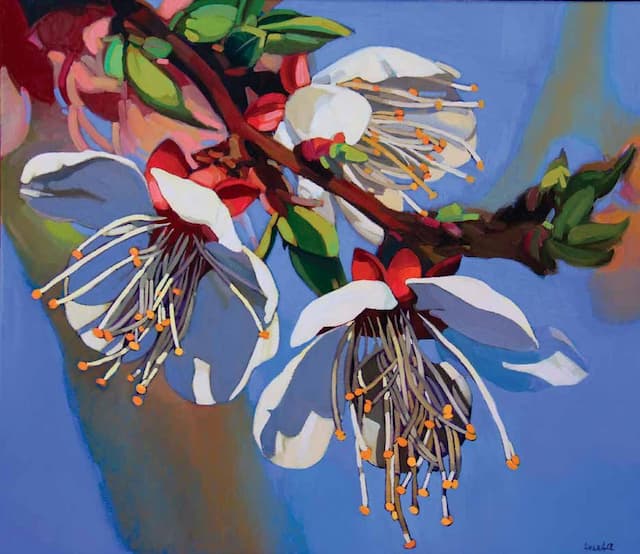
April Bloom. 2017

Anar Abzhanova
Painter
in the Global World
This project is one product of the long-standing partnerships between the Kazakh Research Institute for Culture (Astana, Kazakhstan) and many international museums around the world, including the Smithsonian Institution’s Asian Cultural History Program (Washington, D.C.). Our aim is to introduce some of the range and quality of modern art in Kazakhstan, both to Kazakhstan’s readers and to a diverse global audience. We attempt to do this by presenting a short biography of each artist alongside a small sampling of artworks each has created, from our selection of preeminent living artists of Kazakhstan. We recognize that any single initiative can only include a small portion of the vast artistic productivity within this rapidly growing and developing nation. We are very aware that many more artists are currently active in Kazakhstan, and that no possible selection within a reasonable scope could claim to fully represent the variety and range of art produced. Yet we are also aware that despite the great recent growth of Kazakhstan’s museum and art gallery sectors, very little information about Kazakhstan’s modern art is currently available in English and to international audiences. We hope visitors to this website will enjoy the present selection of artists and artistry, and that they may be inspired to learn more or visit Kazakhstan’s centers of art production and display. There, they will find a very active world of museums, galleries, studios, and creative spaces, often steeped in traditional Kazakh cultural forms and traditions, yet presented in many innovative and cosmopolitan media and formats.
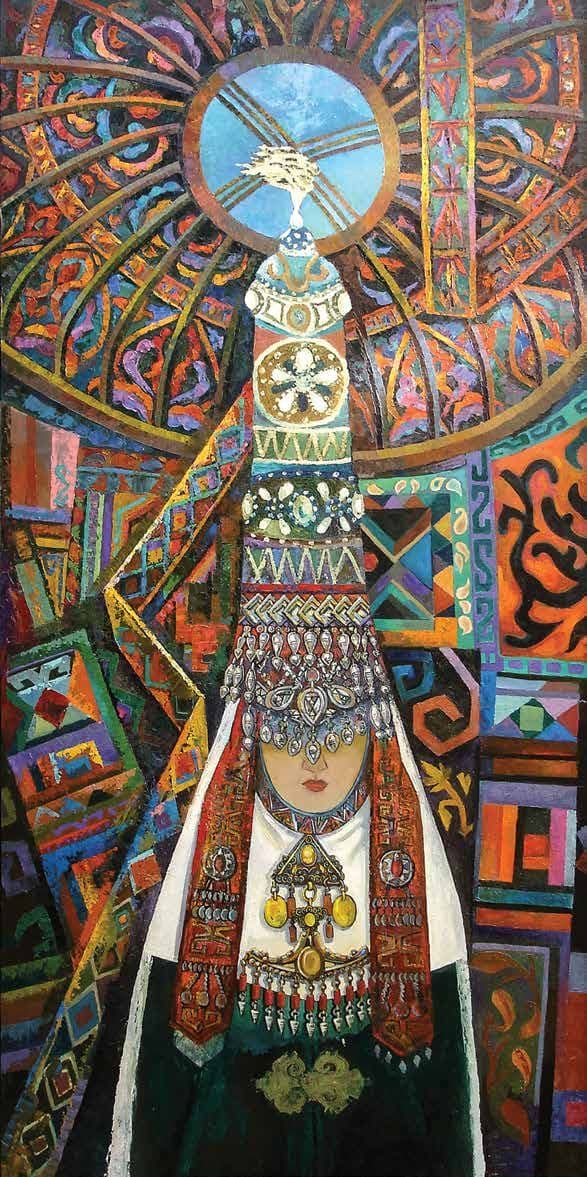
Saukele. 2018

Amandos Akanayev
Painter
This compilation and presentation is part of a larger national effort within Kazakhstan’s Ministry of Culture and Sports, particularly its Kazakh Research Institute of Culture, to enhance partnerships with international museums and to find new ways of introducing Kazakhstan’s art to a global audience. This process is also part of a series of activities carried out within the framework of Kazakhstan’s national cultural policy, which aims both to rediscover Kazakhstan’s own national identity based on Kazakh history and culture, while also finding a uniquely Kazakh inspiration for the transformation and modernization of Kazakhstan’s cultural life. Scholars and art historians who look back from the future on these decades of Kazakhstan’s rapid growth and modernization will surely have much to observe and write about. They will note how the highly diverse individual artists of Kazakhstan sought out unique ways to integrate traditional Kazakh motifs, symbols, and themes within artistic productions and media for a cosmopolitan art market or global artistic forum. Each of the artists we highlight here is inspired both by deep roots in Kazakhstan and by contemporary global trends in art production.
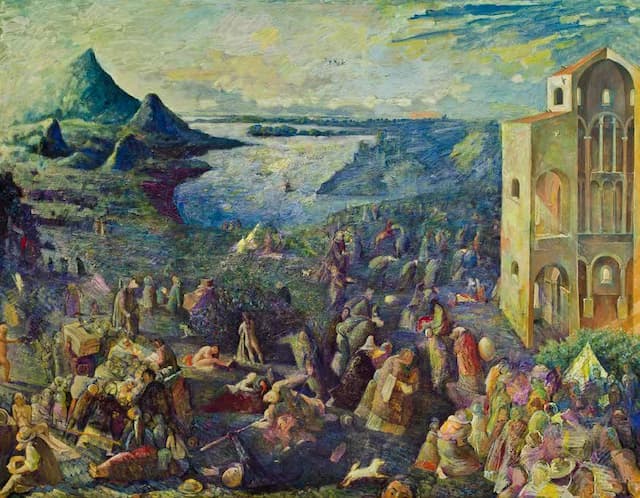
Morning, or the Parable of the Blind. 2014

Dulat Aliyev
Painter
This compilation owes much to the Committee of Experts recently formed within Kazakhstan’s Ministry of Culture, for their suggestions about artists to be included, and about other means for recognizing and celebrating Kazakhstan’s national identity through the visual arts. A list of the Expert Committee members, many of whom nominated individual artists, follows this note. We also thank the curators who assisted in assembling documentation about the artists themselves. We received many suggestions for the selection of artists to be included here, for which we bear full responsibility – only hoping that this initial attempt to introduce some of Kazakhstan’s preeminent artists to a global audience may be followed by many others. It is our sincere hope that through this platform, both Kazakh and international visitors will discover or re-discover the depth and range of artistic production in modern Kazakhstan, and will be inspired to experience first-hand both the depth of Kazakhstan’s cultural traditions and the dynamism of Kazakhstan’s cosmopolitan artistic landscapes.
Dialogue of Cultures:
Kazakhstan
in the Global World

April Bloom. 2017

Anar Abzhanova
Painter
This compilation and presentation is part of a larger national effort within Kazakhstan’s Ministry of Culture and Sports, particularly its Kazakh Research Institute of Culture, to enhance partnerships with international museums and to find new ways of introducing Kazakhstan’s art to a global audience. This process is also part of a series of activities carried out within the framework of Kazakhstan’s national cultural policy, which aims both to rediscover Kazakhstan’s own national identity based on Kazakh history and culture, while also finding a uniquely Kazakh inspiration for the transformation and modernization of Kazakhstan’s cultural life. Scholars and art historians who look back from the future on these decades of Kazakhstan’s rapid growth and modernization will surely have much to observe and write about. They will note how the highly diverse individual artists of Kazakhstan sought out unique ways to integrate traditional Kazakh motifs, symbols, and themes within artistic productions and media for a cosmopolitan art market or global artistic forum. Each of the artists we highlight here is inspired both by deep roots in Kazakhstan and by contemporary global trends in art production.

Morning, or the Parable of the Blind. 2014

Dulat Aliyev
Painter
This project is one product of the long-standing partnerships between the Kazakh Research Institute for Culture (Astana, Kazakhstan) and many international museums around the world, including the Smithsonian Institution’s Asian Cultural History Program (Washington, D.C.). Our aim is to introduce some of the range and quality of modern art in Kazakhstan, both to Kazakhstan’s readers and to a diverse global audience. We attempt to do this by presenting a short biography of each artist alongside a small sampling of artworks each has created, from our selection of preeminent living artists of Kazakhstan. We recognize that any single initiative can only include a small portion of the vast artistic productivity within this rapidly growing and developing nation. We are very aware that many more artists are currently active in Kazakhstan, and that no possible selection within a reasonable scope could claim to fully represent the variety and range of art produced. Yet we are also aware that despite the great recent growth of Kazakhstan’s museum and art gallery sectors, very little information about Kazakhstan’s modern art is currently available in English and to international audiences. We hope visitors to this website will enjoy the present selection of artists and artistry, and that they may be inspired to learn more or visit Kazakhstan’s centers of art production and display. There, they will find a very active world of museums, galleries, studios, and creative spaces, often steeped in traditional Kazakh cultural forms and traditions, yet presented in many innovative and cosmopolitan media and formats.

Saukele. 2018

Amandos Akanayev
Painter

Saukele. 2018

Amandos Akanayev
Painter
This compilation owes much to the Committee of Experts recently formed within Kazakhstan’s Ministry of Culture, for their suggestions about artists to be included, and about other means for recognizing and celebrating Kazakhstan’s national identity through the visual arts. A list of the Expert Committee members, many of whom nominated individual artists, follows this note. We also thank the curators who assisted in assembling documentation about the artists themselves. We received many suggestions for the selection of artists to be included here, for which we bear full responsibility – only hoping that this initial attempt to introduce some of Kazakhstan’s preeminent artists to a global audience may be followed by many others. It is our sincere hope that through this platform, both Kazakh and international visitors will discover or re-discover the depth and range of artistic production in modern Kazakhstan, and will be inspired to experience first-hand both the depth of Kazakhstan’s cultural traditions and the dynamism of Kazakhstan’s cosmopolitan artistic landscapes.





